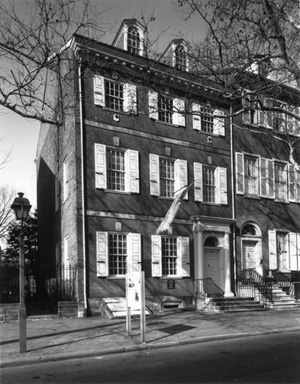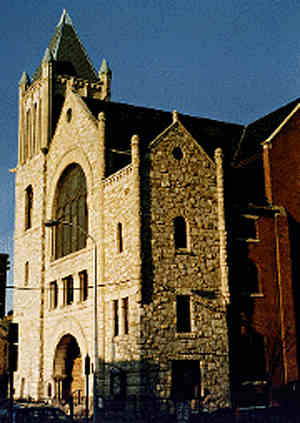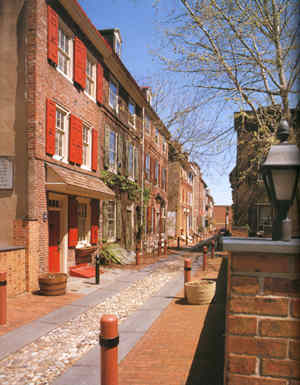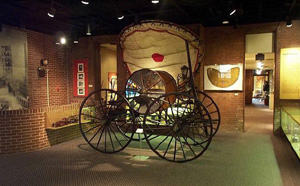
POWEL
HOUSE
215/627-0364
244 South Third Street (between Walnut and Spruce Streets)
Completed in 1765, the Powel House is one of seven residences collectively known as Mansion Row. Samuel Powel (the last mayor of Philadelphia under the Crown and the first mayor after the Revolution) lived here with his wife, Elizabeth Willing Powel. The sophisticated interior plan (compared to a typical town house) included a generous hallway and a ballroom, where legendary figures such as generals Washington and Lafayette were entertained. Hours are usually Thursday–Saturday noon–5 p.m., Sunday 1 p.m.–5 p.m. Call ahead.
MOTHER
BETHEL AFRICAN METHODIST
EPISCOPAL CHURCH
215/925-0616
6th Street between Pine and Lombard Streets
This place of worship is the "mother" church of the African Methodist Episcopal denomination, which separated from white Methodists in 1816. Bethel had been founded several years earlier by Richard Allen—a freed slave who started his own congregation, because black leadership was not wanted at St. George's Methodist Church (4th Street, between Race and Vine Streets). The current late-19th-century building is the fourth on the site. (The first church was in an old blacksmith shop that Allen moved to this lot in 1794.) A small museum in the basement contains the tomb of Allen and artifacts from the Underground Railroad. Designed by Hazelhurst and Huckel in the Romanesque Revival style, the church is open for tours Tuesday–Saturday, 10 a.m.–4 p.m. (last tour at 2 p.m.).
SOCIETY
HILL SYNAGOGUE
215/922-6590
Spruce Street between 4th and 6th Streets
Originally the Spruce Street Baptist Church, this Greek Revival-style building became a Roumanian synagogue in 1910, one of a dozen ethnic Jewish congregations then in the neighborhood. In 1967, when the area's revitalization began, a new congregation—Society Hill Synagogue—made substantial repairs and restored the facade to the initial 1851 design of architect Thomas Ustick Walter. Guided tours Monday–Friday, 10 a.m.–3 p.m.
INDEPENDENCE
SEAPORT MUSEUM
http://seaport.philly.com
215/925-5439
211 South Columbus Boulevard (foot of Walnut Street, at the Delaware
River)
Once
known as the Philadelphia Maritime Museum, the Independence Seaport Museum
relocated
in 1995 to a site built for the United States Bicentennial (Port of History
Museum). The museum explores the role the Port of Philadelphia has played
in immigration, commerce, defense, and recreation. It features more than
20 interactive exhibits and more than 10,000 maritime artifacts, including
uniforms, navigational instruments, and model ships. Not far from the
museum's door, at Columbus Boulevard and Spruce Street, visitors can
tour
the "real things": the 1892 cruiser Olympia and the World
War II submarine Becuna. Museum hours: Daily 10 a.m.–5 p.m.
THE
BOURSE
www.bourse-pa.com
215/625-0300, ext. 15
11 South 5th Street (between Chestnut & Market Streets)
Located 50 yards from
Independence Hall and the Liberty Bell, the Bourse was completed in 1895
to accommodate a variety of financial institutions, including the Maritime
Exchange and the Stock Exchange. Brother architects G. W. and W. D. Hewitt
of Philadelphia designed a block-long building of steel-frame construction,
clad in red sandstone and Pompeian brick. In 1982, the building was extensively
renovated (by the local architectural firm H2L2) to become a food court
and retail stores on multiple levels within a 10-story-high atrium. Commercial
offices overlook the skylit Great Hall.
CHRIST
CHURCH
215/922-1695
20 North American Street (just off 2nd and Market Streets)
Between 1727 and 1744, the Anglicans of the Church England replaced their old 1697 wooden church with a brick, Georgian Colonial-style gem, now a National Historic Landmark. The 196-foot-high steeple (added in 1754) was largely financed through a lottery organized by Benjamin Franklin. Brass plaques mark the pews of George Washington and William Morris, among others. The graves of five signers of the Declaration of Independence are located in the Christ Church Burial Grounds at 5th and Arch Streets. Church open Monday–Saturday 9 a.m.–5 p.m., Sunday 1 p.m.–5 p.m. Sunday services at 9 a.m. and 11 a.m.
ELFRETH'S
ALLEY
215/574-0560, museum phone
Off North 2nd Street, between Arch and Race Streets
The oldest continuously occupied street in the country, tiny Elfreth's Alley dates to 1703. Number 124, built for a colonial-era craftsperson (a dressmaker who lived on the second floor) and Number 126 (the Windsor Chair Maker's House) serve as a museum. During a few special days and/or evenings in June and December, many of these 30 Georgian Colonial and Federal-style houses (built between 1728 and 1836) are open for public tours. Museum hours vary by season.
FIREMAN'S
HALL MUSEUM
215-923-1438
147 North 2nd Street (near Race Street)
Housed in an 1876 former firehouse, the Fireman's Hall Museum is operated by the Philadelphia Fire Department. The collection, starting with the colonial era, includes hand- and horse-drawn firefighting equipment. Visitors can see period living quarters on the second floor. Open Tuesday–Saturday 9 a.m.–4:30 p.m.
PENN'S
LANDING
For information on summer events at Penn's Landing, call:
215/922-2-FUN (215/922-2386)
Extending from South Street to Vine Street, Penn's Landing is a mile-long, redeveloped portion of industrial waterfront along the Delaware River—where two municipal piers and a ferry terminal once stood. The name Penn's Landing is a modern-day misnomer (William Penn actually landed at Upland, now called Chester). After plans for a much-heralded family entertainment center fell through, public discussion has begun on how to better connect the waterfront to Center City (Interstate 95 is a barrier) and how to generate the most appropriate new uses.
![]()

Powel House.

Mother Bethel African Methodist Episcopal Church.

Elfreth's Alley.

Fireman's Hall Museum.